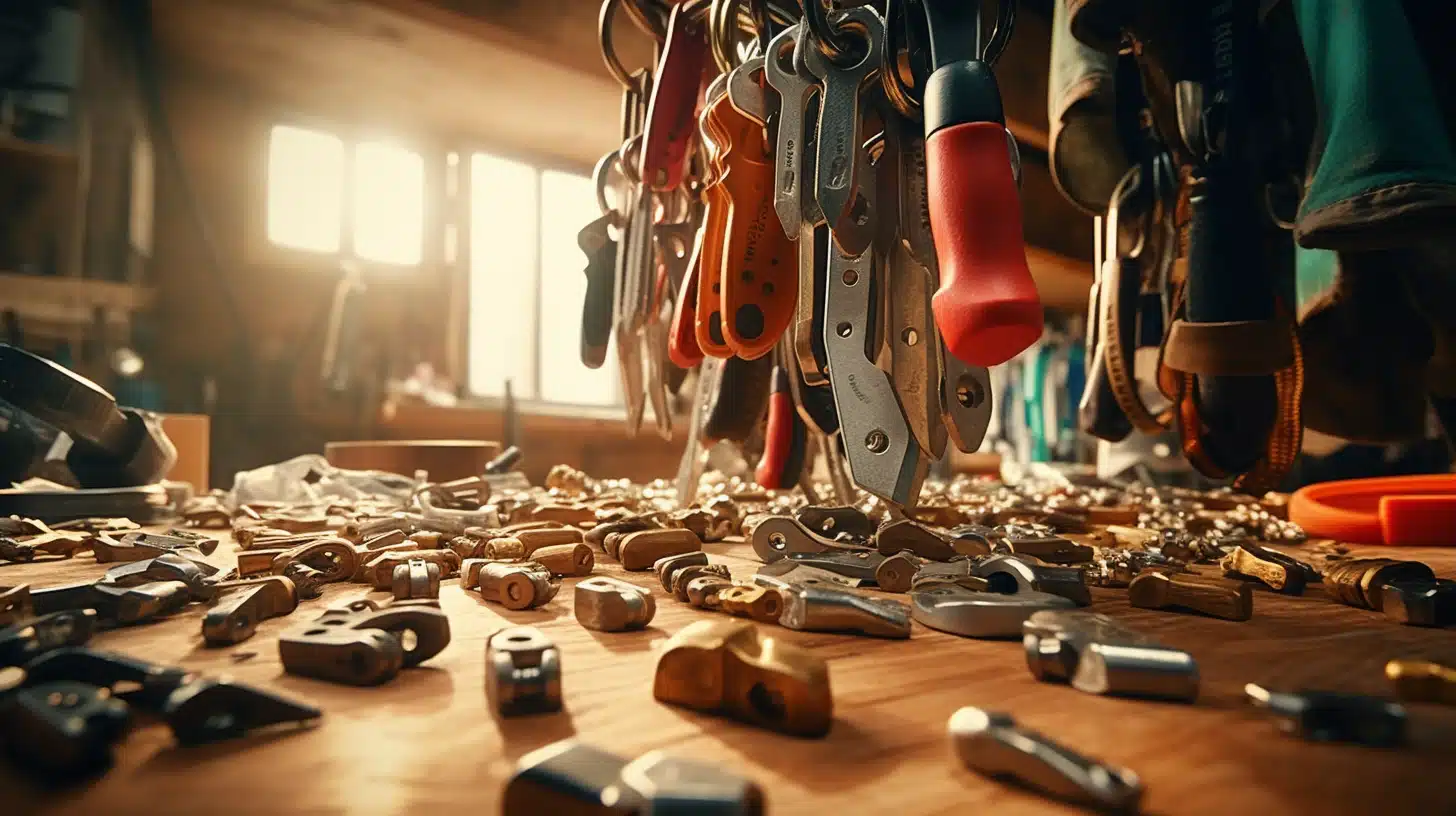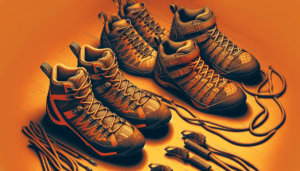Table of Contents
ToggleIntroduction to Trad Climbing Hexes
As a rock climber, I can tell you that trad climbing brings a unique set of challenges and thrills. One of the crucial elements of trad climbing is the correct use of gear, and if you’re interested in this discipline, you’ll want to familiarize yourself with trad climbing hexes.
What are Hexes?
Hexes are a type of passive rock climbing protection that can be placed into natural cracks and features in the rock. They’re made of metal and have a hexagonal shape, which allows them to fit into a wide range of crack sizes.
Now, you might be wondering how hexes work. They can be used ‘passively’, just like nuts; by being wedged into constrictions and tapered cracks. But hexes can also be placed in ‘active mode’, so that they ‘cam’ into the crack. When a hex is positioned this way and then pulled downwards, it tries to rotate, applying increasing outward pressure onto the sidewalls of the crack, which locks it in position. But remember, when using a hex in active mode, it’s still good to place it in a constriction as they can be unreliable in perfectly parallel-sided cracks.
Where to Use Hexes
Hexes are versatile and lightweight, making them a popular choice among trad climbers. They can provide reliable protection in certain types of rock formations, such as parallel-sided cracks or irregular features. More importantly, hexes work in dirty, wet, or icy cracks where cams are likely to slide out. They are also lighter than the equivalent sized cam, and they cost a lot less too (VDiff Climbing).
You can use hexes in a variety of climbing situations, including trad climbing, alpine climbing, and aid climbing. But since they’re a type of passive protection, they won’t move or expand once they’re placed in the rock. This makes them a trustworthy addition to your trad climbing gear set.
As you progress on your climbing journey, remember that gathering the appropriate equipment, including hexes, is half the battle. The other half involves mastering the techniques and skills to use them effectively. So, if you’re ready to take the plunge into the thrilling world of trad climbing, hexes could be your new best friend.
Advantages of Using Hexes
If you’re new to the world of trad climbing, you might be wondering why some climbers swear by their hexes. As an important piece of trad climbing gear, hexes offer several advantages that can be beneficial in various climbing scenarios.
Versatility of Hexes
One of the main advantages of hexes is their versatility. Hexes are lightweight and can provide reliable protection in certain types of rock formations, such as parallel-sided cracks or irregular features REI. This makes them a popular choice among trad climbers.
Hexes can be used in various climbing scenarios, from alpine routes with long, steep uphill approaches to traditional cragging. They are particularly useful in terrain where other forms of protection, such as trad climbing cams, might not be as effective.
For instance, in irregular or chossy cracks, where the rock quality might not be optimal, hexes can provide a secure placement Mountain Project. This versatility makes hexes a crucial addition to your trad climbing tradrack.
Economic Benefits of Hexes
Hexes can also be an economical option for climbers on a tight budget. In comparison to other pieces of climbing protection, hexes are generally more affordable. You can often find used hexes for a lower price, making them a cost-effective way to build up your gear collection Mountain Project.
Furthermore, hexes can serve as lightweight alternatives to large cams. This can be particularly beneficial in areas with steep uphill approaches, where every ounce counts.
Hexes can also be used as an alternative to purchasing more cams, especially in medium and large sizes. They are useful for setting anchors and can be used on lead, although their usage may decrease as climbing difficulty increases Mountain Project.
While there is a learning curve associated with placing hexes effectively, the economic benefits they offer make them a worthy investment for both beginner and experienced climbers. Whether you’re just starting your trad climbing journey or looking to expand your gear collection, consider adding some hexes to your rack. Check out our trad climbing for beginners guide for more tips and advice on getting started with trad climbing.
Disadvantages of Using Hexes
While trad climbing hexes are a great addition to any climber’s gear set, they do come with their share of challenges. In this section, we’ll explore the potential downsides of using hexes, including placement difficulties and comparisons with cams.
Placement Challenges
One of the main drawbacks of using hexes is that they can be more difficult and time-consuming to place compared to cams. According to Mountain Project, hexes can be finicky in certain placements and may not be practical for everyday cragging near parking lots.
Furthermore, the effectiveness of hexes can greatly depend on the type of rock you’re climbing. Metamorphic rocks like quartzite and granite are better suited for hex placements, while other types of rock may pose more challenges. The choice between wire and sling hexes can also depend on the size of the hex. Stiffer wires are more suitable for smaller sizes while flexible slings are less likely to dislodge larger hexes.
If you’re considering adding hexes to your trad climbing gear, it’s essential to practice trad climbing gear placement and become comfortable with their unique properties.
Comparison with Cams
When compared to cams, hexes might fall short in some aspects. For one, they won’t go to many places where cams can go, as stated in the Mountain Project forum. Cams are also easier to place and offer a level of speed and security that hexes might not match, especially if you’re focused on tackling harder routes.
However, this doesn’t mean that hexes are obsolete or not worth considering. They are lighter and cheaper than cams, especially in medium and large sizes, making them a cost-effective option for many climbers. They can be particularly useful for setting anchors and can be used on lead climbs, although they might be carried less as climbing difficulty increases.
In the end, the decision of whether to use hexes or cams will largely depend on your personal climbing style and preferences. If you enjoy long, easy, or moderate climbs, you might find hexes to be a reliable and lightweight addition to your gear set. On the other hand, if your focus is on climbing at your limit, you might prefer the speed and security offered by trad climbing cams.
Remember, the most important aspect of any climbing gear is safety. Whether you’re using hexes, cams, or a combination of both, make sure you are well-versed in trad climbing safety practices and always double-check your gear placements.
Insights on Hex Selection
Selecting the right hexes can be a game-changer for your trad climbing experience. In this section, I’ll guide you through the process of choosing between wire and sling hexes and introduce some popular hex brands.
Choosing between Wire and Sling
The choice between wire and sling hexes largely depends on the size of the hex you’re considering. Stiff wires are generally better for smaller hexes, while larger hexes may benefit from flexible slings, which are less likely to dislodge the hex in certain placements. Some climbers suggest using Titan cord to minimize flopping in larger hexes.
When selecting your hexes, it’s important to consider your climbing style, the routes you’ll be tackling, and your personal preference in terms of handling and placement. Don’t forget, practice makes perfect! Getting comfortable with your gear is crucial, so take the time to practice placements with your hexes, whether on the ground or on easier routes.
Popular Hex Brands
There are several reputable brands that manufacture high-quality hexes. Here are a couple of top picks:
-
WC Rockcentrics: These hexes are a solid choice, offering a full range of sizes. They lack the extendable sling found on some other models, but you can often find them used for a lower cost, making them a great budget-friendly option.
-
DMM Torque Nuts: These hexes are particularly convenient due to their extendable slings. However, they only come in 4 sizes and can be a bit pricier. Still, many climbers find the extra cost worth it for the versatility they provide.
-
BD Hexcentrics: While not as highly recommended as the other two options, BD Hexcentrics can be found cheaply if you’re patient. They might not be the first choice for many climbers, but they can serve as a decent starting point if you’re new to using hexes (Mountain Project).
Remember, the best hexes for you will depend on your specific needs and preferences. Consider the size, weight, ease of use, and cost when making your selection. And of course, remember to always prioritize safety in all of your climbing endeavors. Check out our trad climbing safety guide for more information.
Hex Usage in Different Climbing Scenarios
Let’s now explore how trad climbing hexes are used in different climbing scenarios. As they say, the right tool for the right job, and hexes are certainly a versatile tool in the climbing world.
Hexes in Alpine Climbing
In alpine climbing scenarios, hexes shine due to their lightness and versatility. They’re great for setting anchors and can be a handy addition to your trad climbing gear when you’re high up in the alpine environment.
Hexes can be particularly effective in irregular, chossy, or slimy cracks, where more modern gear like cams might not be as secure (Mountain Project).
However, remember that hexes can be more time-consuming to place than cams. They require careful placement and can be a bit finicky to get just right. So always take your time when placing hexes and make sure they’re secure before moving on.
Hexes in Trad Climbing
When it comes to trad climbing, hexes are a bit of a mixed bag. They can absolutely be used on lead climbs, but they tend to be carried less frequently as climbers progress to harder climbs (Mountain Project).
On one hand, they are a cost-effective alternative to buying more cams, especially in medium and large sizes. They can also be more suitable for certain types of rock, such as metamorphic rock like quartzite and granite.
On the other hand, they won’t go many places where cams can go. For everyday cragging, you may not miss them if they’re not on your trad rack. But for those starting out in trad climbing, or those looking to supplement their gear on a budget, hexes can certainly have a place.
Remember, every climb is different, and the best gear for the job will depend on the specifics of the route and the rock. Understanding the strengths and weaknesses of hexes can help you decide when to use them, and when to reach for something else. For more information, check out our article on trad climbing gear placement.
So, whether you’re planning an alpine ascent or a day of cragging, keep those hexes handy. They might just be the perfect piece for the job!
Additional Tips and Tricks
Becoming a proficient trad climber is not just about having the right gear, like trad climbing hexes, but also about knowing the different techniques and strategies you can employ to tackle various climbing scenarios. In this section, I’ll provide some additional tips on using hexes as gear pulls and transitioning from hexes to cams.
Using Hexes as Gear Pulls
Hexes can serve multiple purposes in a trad rack, one of them being used as gear pulls (Mountain Project). This may come in handy in scenarios where you need to extract stuck gear or need an additional bit of leverage while navigating a tricky placement.
To use a hex as a gear pull, you simply need to attach it to the piece of gear that’s stuck, and then gently tug on it. The added leverage should help loosen the gear, making it easier to remove. This technique can save you a lot of time and energy on the wall, especially during long and demanding routes.
However, keep in mind that like any climbing technique, using hexes as gear pulls requires practice. It’s important to experiment with this technique during less challenging climbs or even while you’re on the ground to get a feel for it.
Transitioning from Hexes to Cams
Many climbers eventually transition from hexes to cams, and some may end up not using hexes anymore. However, there are climbers who still use hexes in situations where they need doubles of large cams or are budget constrained, as hexes can often be found at a cheaper price when purchased used (Mountain Project).
Learning to place passive protection, such as hexes, can be beneficial for those new to trad climbing. It helps develop efficient placement skills and the ability to choose the right size piece. Starting with hexes can provide valuable experience before transitioning to cams (Mountain Project).
However, some climbers believe it is more advisable to save money for cams rather than investing in hexes, as they may not be used extensively once the climbing difficulty increases. The preference for cams over hexes may also be influenced by personal climbing style and ability.
Transitioning from hexes to cams is a personal choice and depends on various factors such as the type of climbs you’re tackling, your climbing goals, and budget. While cams might offer quicker and more secure placements, hexes provide a cost-effective alternative and can offer valuable learning experiences.
My advice would be to keep an open mind and try different pieces of gear. After all, mastering trad climbing techniques is all about adaptation and flexibility!









